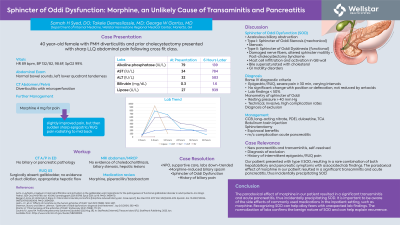Monday Poster Session
Category: Biliary/Pancreas
P1542 - Sphincter of Oddi Dysfunction: Morphine, an Unlikely Cause of Pancreatitis and Transaminitis
Monday, October 23, 2023
10:30 AM - 4:15 PM PT
Location: Exhibit Hall

Has Audio

Samah Syed, DO
Wellstar Kennestone
Marietta, GA
Presenting Author(s)
Samah Syed, DO
Wellstar Kennestone, Marietta, GA
Introduction: Morphine is the most frequently used analgesic in the inpatient setting. Side effects include sedation, nausea, and mild respiratory depression. A rather uncommon side effect is biliary spasm, which can mimic, or reveal, sphincter of Oddi dysfunction (SOD).
Case Description/Methods: A 40-year-old female with a history of diverticulitis and a prior cholecystectomy presented with sharp, constant left lower quadrant abdominal pain following a cross fit class. Vitals were stable and exam findings significant for normoactive bowel sounds and moderate left lower quadrant tenderness. Labs revealed mild leukocytosis and unremarkable liver function tests (LFTs). Imaging confirmed diverticulitis with colonic microperforation. She received morphine which slightly improved her symptoms, but then she began to have sharp epigastric pain radiating to the mid back. Follow up labs revealed a marked elevation in her LFTs and lipase. Within 6 hours, her alkaline phosphatase increased from 79 to 193 IU/L, AST from 34 to 784 IU/L, ALT from 32 to 583 IU/L, bilirubin from 0.3 to 1.6 mg/dL, and lipase from 28 to 939 U/L.
A right upper quadrant doppler ultrasound revealed a surgically absent gallbladder, no evidence of biliary duct dilation, and appropriate hepatic blood flow. MRI abdomen/MRCP showed no evidence of choledocholithiasis, biliary stenosis, or hepatic lesions. The only medications she received between the two lab draws were morphine and Piperacillin/Tazobactam. Though the antibiotic can cause LFT elevation, one antibiotic dose is unlikely to cause such a significant change. Labs were followed every four hours and began to improve within 24 hours.
Discussion: SOD, also known as post-cholecystectomy syndrome, is theorized to be related to damaged nerve fibers resulting in altered sphincter motility. This results in an acalculous, functional or mechanical, biliary obstruction. Type I dysfunction describes sphincter of Oddi stenosis, while type II dysfunction describes sphincter of Oddi dyskinesia. Our patient presented with type II SOD, resulting in a rare combination of both hepatobiliary and pancreatic symptoms with associated lab findings.
The paradoxical effect of morphine in our patient resulted in a significant transaminitis and acute pancreatitis, thus incidentally precipitating SOD. Recognizing SOD can help allay fears with unexpected lab findings. The normalization of labs confirms the benign nature of SOD and can help explain recurrence.
Disclosures:
Samah Syed, DO. P1542 - Sphincter of Oddi Dysfunction: Morphine, an Unlikely Cause of Pancreatitis and Transaminitis, ACG 2023 Annual Scientific Meeting Abstracts. Vancouver, BC, Canada: American College of Gastroenterology.
Wellstar Kennestone, Marietta, GA
Introduction: Morphine is the most frequently used analgesic in the inpatient setting. Side effects include sedation, nausea, and mild respiratory depression. A rather uncommon side effect is biliary spasm, which can mimic, or reveal, sphincter of Oddi dysfunction (SOD).
Case Description/Methods: A 40-year-old female with a history of diverticulitis and a prior cholecystectomy presented with sharp, constant left lower quadrant abdominal pain following a cross fit class. Vitals were stable and exam findings significant for normoactive bowel sounds and moderate left lower quadrant tenderness. Labs revealed mild leukocytosis and unremarkable liver function tests (LFTs). Imaging confirmed diverticulitis with colonic microperforation. She received morphine which slightly improved her symptoms, but then she began to have sharp epigastric pain radiating to the mid back. Follow up labs revealed a marked elevation in her LFTs and lipase. Within 6 hours, her alkaline phosphatase increased from 79 to 193 IU/L, AST from 34 to 784 IU/L, ALT from 32 to 583 IU/L, bilirubin from 0.3 to 1.6 mg/dL, and lipase from 28 to 939 U/L.
A right upper quadrant doppler ultrasound revealed a surgically absent gallbladder, no evidence of biliary duct dilation, and appropriate hepatic blood flow. MRI abdomen/MRCP showed no evidence of choledocholithiasis, biliary stenosis, or hepatic lesions. The only medications she received between the two lab draws were morphine and Piperacillin/Tazobactam. Though the antibiotic can cause LFT elevation, one antibiotic dose is unlikely to cause such a significant change. Labs were followed every four hours and began to improve within 24 hours.
Discussion: SOD, also known as post-cholecystectomy syndrome, is theorized to be related to damaged nerve fibers resulting in altered sphincter motility. This results in an acalculous, functional or mechanical, biliary obstruction. Type I dysfunction describes sphincter of Oddi stenosis, while type II dysfunction describes sphincter of Oddi dyskinesia. Our patient presented with type II SOD, resulting in a rare combination of both hepatobiliary and pancreatic symptoms with associated lab findings.
The paradoxical effect of morphine in our patient resulted in a significant transaminitis and acute pancreatitis, thus incidentally precipitating SOD. Recognizing SOD can help allay fears with unexpected lab findings. The normalization of labs confirms the benign nature of SOD and can help explain recurrence.
Disclosures:
Samah Syed indicated no relevant financial relationships.
Samah Syed, DO. P1542 - Sphincter of Oddi Dysfunction: Morphine, an Unlikely Cause of Pancreatitis and Transaminitis, ACG 2023 Annual Scientific Meeting Abstracts. Vancouver, BC, Canada: American College of Gastroenterology.
